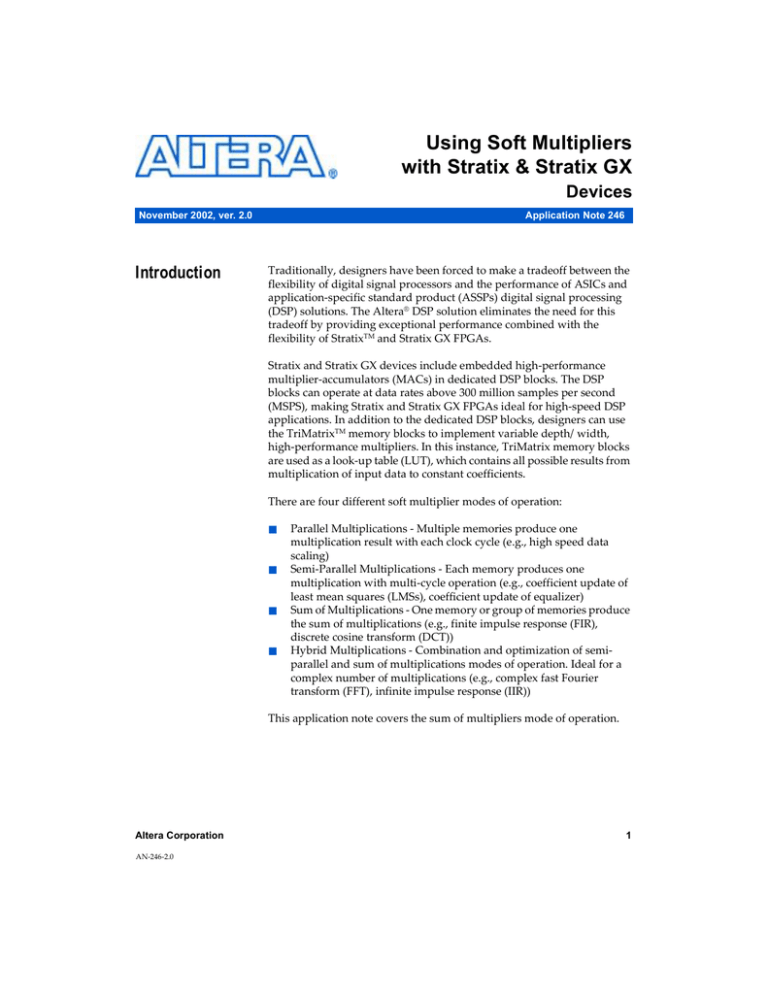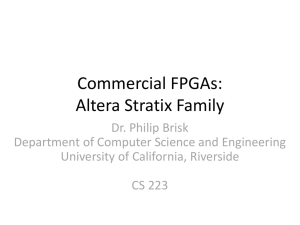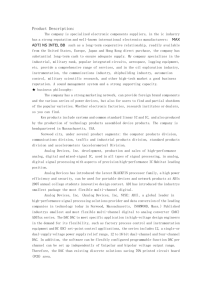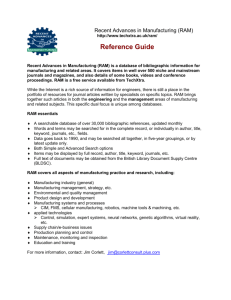
Using Soft Multipliers
with Stratix & Stratix GX
Devices
November 2002, ver. 2.0
Introduction
Application Note 246
Traditionally, designers have been forced to make a tradeoff between the
flexibility of digital signal processors and the performance of ASICs and
application-specific standard product (ASSPs) digital signal processing
(DSP) solutions. The Altera® DSP solution eliminates the need for this
tradeoff by providing exceptional performance combined with the
flexibility of StratixTM and Stratix GX FPGAs.
Stratix and Stratix GX devices include embedded high-performance
multiplier-accumulators (MACs) in dedicated DSP blocks. The DSP
blocks can operate at data rates above 300 million samples per second
(MSPS), making Stratix and Stratix GX FPGAs ideal for high-speed DSP
applications. In addition to the dedicated DSP blocks, designers can use
the TriMatrixTM memory blocks to implement variable depth/width,
high-performance multipliers. In this instance, TriMatrix memory blocks
are used as a look-up table (LUT), which contains all possible results from
multiplication of input data to constant coefficients.
There are four different soft multiplier modes of operation:
■
■
■
■
Parallel Multiplications - Multiple memories produce one
multiplication result with each clock cycle (e.g., high speed data
scaling)
Semi-Parallel Multiplications - Each memory produces one
multiplication with multi-cycle operation (e.g., coefficient update of
least mean squares (LMSs), coefficient update of equalizer)
Sum of Multiplications - One memory or group of memories produce
the sum of multiplications (e.g., finite impulse response (FIR),
discrete cosine transform (DCT))
Hybrid Multiplications - Combination and optimization of semiparallel and sum of multiplications modes of operation. Ideal for a
complex number of multiplications (e.g., complex fast Fourier
transform (FFT), infinite impulse response (IIR))
This application note covers the sum of multipliers mode of operation.
Altera Corporation
AN-246-2.0
1
AN 246: Using Soft Multipliers with Stratix & Stratix GX Devices
Stratix &
Stratix GX
Memory & DSP
Blocks
The TriMatrix memories consist of three types of RAM blocks: M512,
M4K, and M-RAM blocks. M512 and M4K RAM blocks are memory
blocks with a maximum width of 18 and 36 bits, respectively, and a
maximum performance of approximately 300 MHz (ideal for soft
multipliers). You can use these memory blocks for DSP applications that
are multiplier intensive, such as imaging and mobile wireless
technologies where the data word size does not fit within the standard 8-,
16-, or 32-bit widths.
Tables 1 and 2 show the number of Stratix and Stratix GX TriMatrix M4K
memory blocks.
Table 1. Stratix TriMatrix Memory Blocks
EP1S10
EP1S20
EP1S25
EP1S30
EP1S40
EP1S60
EP1S80
EP1S120
M512 RAM
(32 × 18 bits)
Feature
94
194
224
295
384
574
767
1,118
M4K RAM
(128 × 36 bits)
60
82
138
171
183
292
364
520
M-RAM
(4K × 144 bits)
1
2
2
4
4
6
9
12
Total RAM bits 920,448 1,669,248 1,944,576 3,317,184 3,423,744 5,215,104 7,427,520 10,118,016
Table 2. Stratix GX M4K Memory Blocks
Feature
EP1SGX25C
EP1SGX25D
EP1SGX25F
EP1SGX40D
EP1SGX40G
M512 RAM (32 × 18 bits)
94
224
384
M4K RAM (128 × 36 bits)
60
138
183
M-RAM (4K × 144 bits)
Total RAM bits
Basics of DSP
Operation
EP1SGX10C
EP1SGX10D
1
2
4
920,448
1,944,576
3,423,744
DSP is an arithmetic-intensive technology. To achieve high-speed signal
processing, arithmetic operation must be accelerated.
Many digital systems use signal filtering to remove unwanted noise to
provide spectral shaping, or to perform signal detection or analysis.
Filters are used with communication applications such as band selection,
low-pass filtering, and video convolution functions. Two types of filters
that provide these functions are FIR and IIR filters. You can use FIR filters
in systems that require a linear phase and have an inherently stable
structure. You can use IIR filters in systems that can tolerate phase
distortion. Typical filter applications include signal pre-conditioning,
band selection, and low-pass filtering.
2
Altera Corporation
AN 246: Using Soft Multipliers with Stratix & Stratix GX Devices
FIR Filter Architecture
The structure of a FIR filter is a weighted, tapped delay line. The filter
design process involves identifying coefficients that match the frequency
response specified for the system. The coefficients determine the response
of the filter. By changing the coefficient values or by adding more
coefficients to the filter, you can change the signal frequencies, which pass
through the filter. Figure 1 shows the basic FIR filter structure.
Figure 1. Basic FIR Filter Structure
xin
Z
-1
C0
Z -1
C1
Z -1
C2
Z -1
C3
Tapped
Delay Line
Coefficient
Multipliers
Adder Tree
yout
The FIR filter function (or many other DSP functions) is based on a MAC
operation. The input data shifts into the shift register. The output of each
register, which is called a tap, is the parallel input to the multiplier. Each
parallel input is multiplied by a coefficient (Cn) as it is presented (see
Figure 1).
MAC Function
The base of many DSP algorithms is a MAC function. The MAC function
is represented by multiplication of a multiplier to a multiplicand, which
implies that each element of the multiplier is multiplied by each bit of the
multiplicand. The partial product of each multiplication is accumulated
according to the weight of the partial product (weight indicates the
location of a bit corresponding to other bits). For example, if a partial
product of bits 4 through 7 is added to a partial product of bits 0 through
3, the partial product of 4 through 7 is shifted according to their weight
and then accumulated to the partial product of previous stages. Figure 2
shows a simple 2 × 2 multiplication of multiplier a1a0 to multiplicand b1b0.
Altera Corporation
3
AN 246: Using Soft Multipliers with Stratix & Stratix GX Devices
Figure 2. Multiplication of Two 2-Bit Numbers
a0
b1
b0
a1
b1
b0
×
+
c3
Half Adder
carry_out Sum
c3
c2
a1 b1
c2
b1
a1
a0 b1
a1 b0
c1
b0
a0
a0 b0
c0
Half Adder
carry_out Sum
c1
c0
Distributed Arithmetic
Distributed arithmetic is a method of performing multiplication by
distributing the operation over many LUTs. Figure 3 shows the fourproduct MAC function that uses sequential shift and add to multiply four
pairs, and then sum their partial product to obtain a final result. Each
multiplier forms partial products by multiplying the coefficient by one bit
of the data at a time using an AND gate.
4
Altera Corporation
AN 246: Using Soft Multipliers with Stratix & Stratix GX Devices
Figure 3. Distributed Arithmetic with Four Constant Multiplicands
Scaling Accumulator
<<1
c0
w
SREG
x
SREG
y
SREG
z
SREG
c1
c2
c3
wc0 + xc1 +yc2 + zc3
At the end of the process, these partial products (of a particular bit) are
summed up and the final stage performs the final shift-accumulate at the
scaling accumulator.
The scaling accumulator shifts the sums of partial products accordingly
and then sums the result. The distributed-arithmetic circuit
simultaneously performs four multiplications and sums the results when
all of products are completed.
DSP
Applications
with Stratix &
Stratix GX
Devices
Altera Corporation
You can use Stratix and Stratix GX RAM blocks to implement DSP
applications. Specifically, you can use the M512 and M4K RAM blocks,
with 32 × 18-bit and 128 × 36-bit capacity, as LUTs to store the
multiplication result of multiplier to multiplicand.
Distributed Arithmetic in LUT
Figure 4 shows how to implement distributed arithmetic using LUTs. The
combined product and adder tree can be reduced to an LUT. The LUT
contains the sums of constant coefficients for all possible input
combinations to the LUT. Finally, the sums of the bits from the LUTs are
added together, keeping in mind that different coefficient multiplications
have different weight. Therefore, some shifting is required before the bit
sums are performed.
5
AN 246: Using Soft Multipliers with Stratix & Stratix GX Devices
Figure 4. Four-Bit Multiplication to Constant Coefficient
Note (1)
c0
w
c1
x
c2
Addr
0000
0001
0010
0011
Data
0
c0
c1
c0 + c1
1110
1111
c1 + c2 + c3
c0 + c1 + c2 + c3
y
c3
z
Note to Figure 4:
(1)
c0 to c 3 are constant coefficients.
LUT Implementation in M512 & M4K RAM Blocks
You can use the Stratix and Stratix GX M512 or M4K RAM memory blocks
as a LUTs to implement multiplication for DSP applications. All possible
combinations of a multiplicand summation are calculated and stored in
the M512 or M4K RAM block as an LUT. As a result, each address in the
memory blocks represent a unique multiplication result.
Each multiplier’s n-data bits load into a shift register at the data rate of
clock/n-data bits. The shift register’s data is the input, which point to an
address location in the M512 or M4K RAM block. The output of the RAM
block indicates the multiplication result for a specific bit, at each clock
cycle.
Figure 5 shows the RAM LUT implementation of four 4-bit data inputs
and up to 16-bit constant coefficients. This implementation takes four
clock cycles to complete multiplication operation by adding partial
products. At each cycle, the addition of partial products will generate one
extra bit as the carry on bit. By the end of fourth cycle, the final addition
of partial products will generate a 22-bit output.
6
Altera Corporation
AN 246: Using Soft Multipliers with Stratix & Stratix GX Devices
Figure 5. Four-Tap FIR Filter Implementation Using M512 RAM Blocks as LUTs
A
(1)
MSB
(2)
B
LSB
MSB
tap 1
C
LSB
D
MSB
LSB
MSB
LSB
tap 2
tap 3
tap 4
M512 RAM
Block (LUT)
16 × 18
Addr
0000
0001
0010
0011
Mult_result
0
c0
c1
c 0 + c1
1111
c0 + c1 + c2 + c3
18
REG
22
REG
22
18
22
Notes to Figure 5 :
(1)
(2)
MSB: most significant bit.
LSB: least significant bit.
For example, Figure 5 shows four 4-bit data inputs called A, B, C, and D.
The input data width determines the length of the shift register (e.g., a 4bit shift register for 4-bit data). The outputs from the shift registers are
called taps (the number of taps is equal to the number of input data). Since
the size for Stratix and Stratix GX M512 RAM blocks is 32 × 18 bits, the
maximum taps for each M512 RAM block is five (25 = 32 addresses).
Depending on the number of inputs, coefficients, taps, and the required
frequency, the number of RAM blocks that are used will vary. The
example in Figure 5 requires only one M512 RAM block.
On each clock cycle, the LSB of each shift register simultaneously shifts
out as inputs to the RAM block. The longer the shift register cycle, the
more clock cycles required to shift out all the data to the RAM block. On
the first cycle, the LSB of data cells A, B, C, and D are multiplied by all four
bits of the coefficients. It will take four clock cycles to multiply the 4-bit
inputs to the 16-bit coefficients.
Altera Corporation
7
AN 246: Using Soft Multipliers with Stratix & Stratix GX Devices
If the FIR filter has more than five taps, you must use multiple M512
blocks or M4K RAM blocks (which are larger memory blocks) to complete
multiplication. The reason for this requirement is that M512 RAM blocks
have a maximum of 32 words (18 bits) per RAM block which is equal to 25
addresses, while M4K RAM blocks have a maximum of 128 words
(36 bits) per RAM block which is equal to 27 addresses. The outputs of
RAM blocks is shift-accumulated according to their weight, and provides
the final multiplication result. Figure 6 shows the multiplication of eight
4-bit data inputs to a 16-bit constant coefficient in two M512 RAM blocks.
The output from the RAM block is an 18-bit output. Since it takes four
clock cycles to complete the multiplication operation (by adding the
partial products), the final output after the forth cycle will be a 23-bit
output.
Figure 6. Using Multiple M512 RAM Blocks for an 8-Tap FIR Filter
1
1
REG
REG
REG
REG
4
REG
REG
REG
REG
M512 RAM
Block (LUT)
16 × 18
M512 RAM
Block (LUT)
16 × 18
18
18
REG
23
REG
23
19
23
Since the application’s performance is determined by the length of the
shift register (MSPS = system clock/N, where N equals the width of input
data bus) for filters that require high performance, Altera recommends
that you split the shift register into smaller shift registers. This technique
increases the performance, but uses more RAM blocks. See Table 1 on
page 2 for the total number of TriMatrix memory blocks.
Also, if the FIR filter requires a coefficient larger than 16 bits, you can use
multiple M512 RAM blocks or use M4K RAM blocks (M4K RAM blocks
can perform multiplication up to a 34-bit coefficient). RAM block outputs
are shifted and accumulated in a scaling accumulator to add up the partial
products together and to obtain a final multiplication result.
8
Altera Corporation
AN 246: Using Soft Multipliers with Stratix & Stratix GX Devices
Figure 7 shows multiplication of seven 16-bit data inputs to a 20-bit
constant coefficient in one M4K RAM block. The 128 addressed lines
correspond to seven data inputs in a M4K RAM block. Performing seven
16-bit × 20-bit multiplications will generate a 23-bit output from a M4K
RAM block. Since it takes 16 clock cycles to complete adding the partial
products, and at each partial product addition one bit is added to the total
number of output bits, the final output is 39 bits.
Figure 7. Using a M4K RAM Block for a 7-Tap FIR Filter
1
REG
REG
REG
REG
REG
REG
REG
M4K RAM
Block (LUT)
128 × 23
7
23
REG
39
REG
39
23
39
1
Altera Corporation
Even though this technique is for a multiplication of constant
coefficients, to change the coefficients, you can rewrite the RAM
blocks since Stratix and Stratix GX memory blocks are dual-port
RAM. This operation is useful for adaptive FIR filters.
9
AN 246: Using Soft Multipliers with Stratix & Stratix GX Devices
DSP Performance (MMAC)
Because digital signal processors are typically assigned MAC-intensive
tasks, the DSP performance is related to MAC throughput. The unit for
DSP speed is million multiply-accumulate operations per second
(MMACS). Tables 3 and 4 show the throughput for DSP applications
implemented in Stratix and Stratix GX RAM blocks for 16 × 16 multipliers,
respectively. Tables 3 and 4 also show the total number of 16 × 16
multipliers that exist within Stratix and Stratix GX M512 and M4K blocks,
respectively.
Table 3. 16 × 16 Multiplier in Stratix RAM Blocks
Device
Notes (1), (2)
Number of Multipliers (3)
M512 Blocks
Performance (MMACS)
M4K Blocks Total Blocks (4)
M512 Blocks
M4K Blocks
Total Blocks (4)
EP1S10
23
30
53
6,900
9,000
15,900
EP1S20
48
41
89
14,000
12,300
26,700
EP1S25
56
69
125
16,800
20,700
37,500
EP1S30
74
85
159
22,200
25,500
47,700
EP1S40
96
91
187
22,800
27,300
56,100
EP1S60
144
146
290
43,200
43,800
87,000
EP1S80
192
182
370
57,600
54,600
112,200
EP1S120
280
260
540
84,000
78,000
162,000
Table 4. 16 × 16 Multiplier in Stratix GX RAM Blocks
Device
Notes (1), (2)
Number of Multipliers (3)
Performance (MMACS)
M512 Blocks
M4K Blocks
Total Blocks (4) M512 Blocks
M4K Blocks
Total Blocks (4)
EP1S10C
23
30
53
6,900
9,000
15,900
EP1S10D
23
30
53
6,900
9,000
15,900
EP1S25C
56
69
125
16,800
20,700
37,500
EP1S25D
56
69
125
16,800
20,700
37,500
EP1S25F
56
69
125
16,800
20,700
37,500
EP1S40D
96
91
187
22,800
27,300
56,100
EP1S40G
96
91
187
22,800
27,300
56,100
Notes to Table 3:
(1)
(2)
(3)
(4)
Both coefficient and input data width are 16 bits.
These values are for four inputs. The number of multipliers will increase by approximately 50% with optimization
of five inputs for M512 blocks and seven inputs for M4K blocks.
The number of multipliers are normalized (divided by 16) to create throughput of one result per clock cycle.
The total number of M512 and M4K blocks in a device.
10
Altera Corporation
AN 246: Using Soft Multipliers with Stratix & Stratix GX Devices
To calculate the MAC throughput, use the following equation:
MMACS = (Frequency (MHz) × number of multipliers in RAM block)
For these calculations, assume that the operation frequency in M512 or
M4K RAM blocks is approximately 300 MHz. It is also assumed that it will
take 16 clock cycles to perform a multiplication operation (due to the
width of the input data).
Software
Implementation
The Altera FIR Compiler MegaCore® function generates FIR filters
customized for Altera devices. You can use the FIR Compiler wizard
interface to implement a variety of filter architectures, including fully
parallel, serial, and multi-bit serial-fixed coefficient filters, and MACbased and multi-cycle variable filters. The wizard also includes a
coefficient generator to help you create filter coefficients.
1
FIR Compiler version 2.6.0 supports FIR filter implementation in
Stratix and Stratix GX TriMatrix memory blocks. You can use
this version of the FIR Compiler to implement soft multiplierbased FIR filters.
The FIR Compiler function speeds up the design cycle by:
■
■
■
■
f
Conclusion
Altera Corporation
Finding the coefficients needed to design custom FIR filters.
Generating bit-accurate and clock-cycle-accurate FIR filter models
(also known as bit-true models) in the Verilog HDL and VHDL
languages, and for the MATLAB environment (Simulink Model Files
and M-Files).
Automatically generating the code required for the MAX+PLUS® II
or Quartus® II software to synthesize high-speed, area-efficient FIR
filters of various architectures.
Creating Quartus II test vectors to test the FIR filter’s impulse
response.
For more information on the FIR Compiler function, refer to FIR Compiler
MegaCore Function User Guide. For more information on FIR Filter and
programmable logic device (PLD) implementation, refer to AN 73:
Implementing FIR Filters in FLEX Devices.
You can use Stratix and Stratix GX DSP blocks to implement DSP
applications. An alternative to DSP block implementation is the use of
Stratix and Stratix GX TriMatrix blocks (M512 or M4K RAM blocks). This
alternative is useful for designs that need more multipliers than are
available using DSP blocks. This implementations is particularly useful
when these multipliers are multiplied by a constant or a value that
infrequently changes, as in an adaptive FIR filter.
11
AN 246: Using Soft Multipliers with Stratix & Stratix GX Devices
Revision
History
101 Innovation Drive
San Jose, CA 95134
(408) 544-7000
http://www.altera.com
Applications Hotline:
(800) 800-EPLD
Literature Services:
lit_req@altera.com
12
The information contained in AN 246: Using Soft Multipliers with Stratix &
Stratix GX Devices version 2.0 supersedes information published in
previous versions. The following change was made in AN 246: Using Soft
Multipliers with Stratix & Stratix GX Devices version 2.0: added Stratix GX
devices throughout the document.
Copyright © 2002 Altera Corporation. All rights reserved. Altera, The Programmable Solutions Company, the
stylized Altera logo, specific device designations, and all other words and logos that are identified as
trademarks and/or service marks are, unless noted otherwise, the trademarks and service marks of Altera
Corporation in the U.S. and other countries. All other product or service names are the property of their
respective holders. Altera products are protected under numerous U.S. and foreign patents and pending
applications, maskwork rights, and copyrights. Altera warrants performance of its
semiconductor products to current specifications in accordance with Altera's standard
warranty, but reserves the right to make changes to any products and services at any time
without notice. Altera assumes no responsibility or liability arising out of the application
or use of any information, product, or service described herein except as expressly agreed
to in writing by Altera Corporation. Altera customers are advised to obtain the latest
version of device specifications before relying on any published information and before
placing orders for products or services.
Altera Corporation






